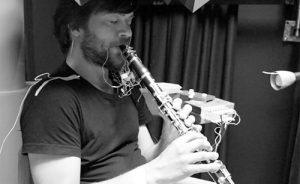 This year’s ClarinetFest included a fascinating lecture on articulation by Dr. Kornel Wolak. Wolak has been conducting research at the Oral Dynamics Laboratories at the University of Toronto Speech-Language Pathology Department together with Drs A. Slis, A. Namasivayam, and P. Van Lieshout to examine the inside of a player’s mouth, in real-time while playing, by observing them with machines such as 3D Electromagnetic Articulograph (EMA) to record movements of the tongue, lips and jaw; Surface Electromyography (sEMG), to record the electrical activity of facial muscles (in particular, those of the lips) involved in playing the clarinet; Respitrace (induction plethysmography), an apparatus to measure respiratory kinematics of chest and abdominal movements during playing which will allow (after proper calibration) to measure air volume and its derivative, airflow; and an audio-video recording device, to record the sound produced and outside shape of the embouchure corresponding to the air support changes across all of the instrument’s registers.
This year’s ClarinetFest included a fascinating lecture on articulation by Dr. Kornel Wolak. Wolak has been conducting research at the Oral Dynamics Laboratories at the University of Toronto Speech-Language Pathology Department together with Drs A. Slis, A. Namasivayam, and P. Van Lieshout to examine the inside of a player’s mouth, in real-time while playing, by observing them with machines such as 3D Electromagnetic Articulograph (EMA) to record movements of the tongue, lips and jaw; Surface Electromyography (sEMG), to record the electrical activity of facial muscles (in particular, those of the lips) involved in playing the clarinet; Respitrace (induction plethysmography), an apparatus to measure respiratory kinematics of chest and abdominal movements during playing which will allow (after proper calibration) to measure air volume and its derivative, airflow; and an audio-video recording device, to record the sound produced and outside shape of the embouchure corresponding to the air support changes across all of the instrument’s registers.
The goals of their research include a better understanding of the relationships the oral articulators (tongue, jaw, and lips), facial muscles, and air pressure play in producing sound on the clarinet, and to create exercises involving the pronunciation of particular syllables which aid in the production and articulation of notes.
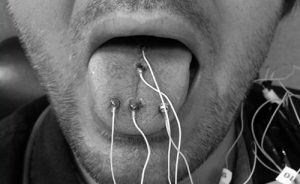 His new booklet, Articulation Types for Clarinet, is intended for use by clarinet instructors, and presents and illustrates various articulation types on the clarinet that he has been researching. It explains the different articulations by providing brief descriptions and accurate figures of oral cavity, and may aid instructors who seek new ways to explain staccato phenomenon as well as other articulation solutions for their pupils.
His new booklet, Articulation Types for Clarinet, is intended for use by clarinet instructors, and presents and illustrates various articulation types on the clarinet that he has been researching. It explains the different articulations by providing brief descriptions and accurate figures of oral cavity, and may aid instructors who seek new ways to explain staccato phenomenon as well as other articulation solutions for their pupils.
The booklet covers the historical background of articulation, the common articulations of single, double, and triple tonguing; alternative articulations of synthetic speed, on-the-reed multiple, and lateral tonguing; and extended articulations of slap-tongue, and various types of flutter-tongues. Here we’ll look at excerpts of the booklet regarding single, double, and lateral tonguing.
Articulation Types for Clarinet
For the purpose of this publication, the meanings of the following terms were simplified as follows:
- ARTICULATION: Is the way a note is being produced.
- STACCATO: Is a type of articulation.
- STACCATO TYPE: Refers to the way staccato articulation is being produced.
- EMBOUCHURE: Total or oral cavity parts participating with sound production.
ABREVIATIONS
- TT: Tongue Tip
- TB: Tongue Body
- TD: Tongue Dorsum
- ST: Single Tonguing
- DT: DoubleTonguing
- TRT: Triple Tonguing
This presentation illustrates the evolution of clarinet articulation by comparing the earliest types, the most common and some more experimental but valid alternative types of staccato. Each articulation style will be represented with a figure that will explain its technique as well as its pros & cons. Let’s briefly review different parts of the mouth cavity [Oral Articulators] and their names that are responsible for production of the clarinet staccato.
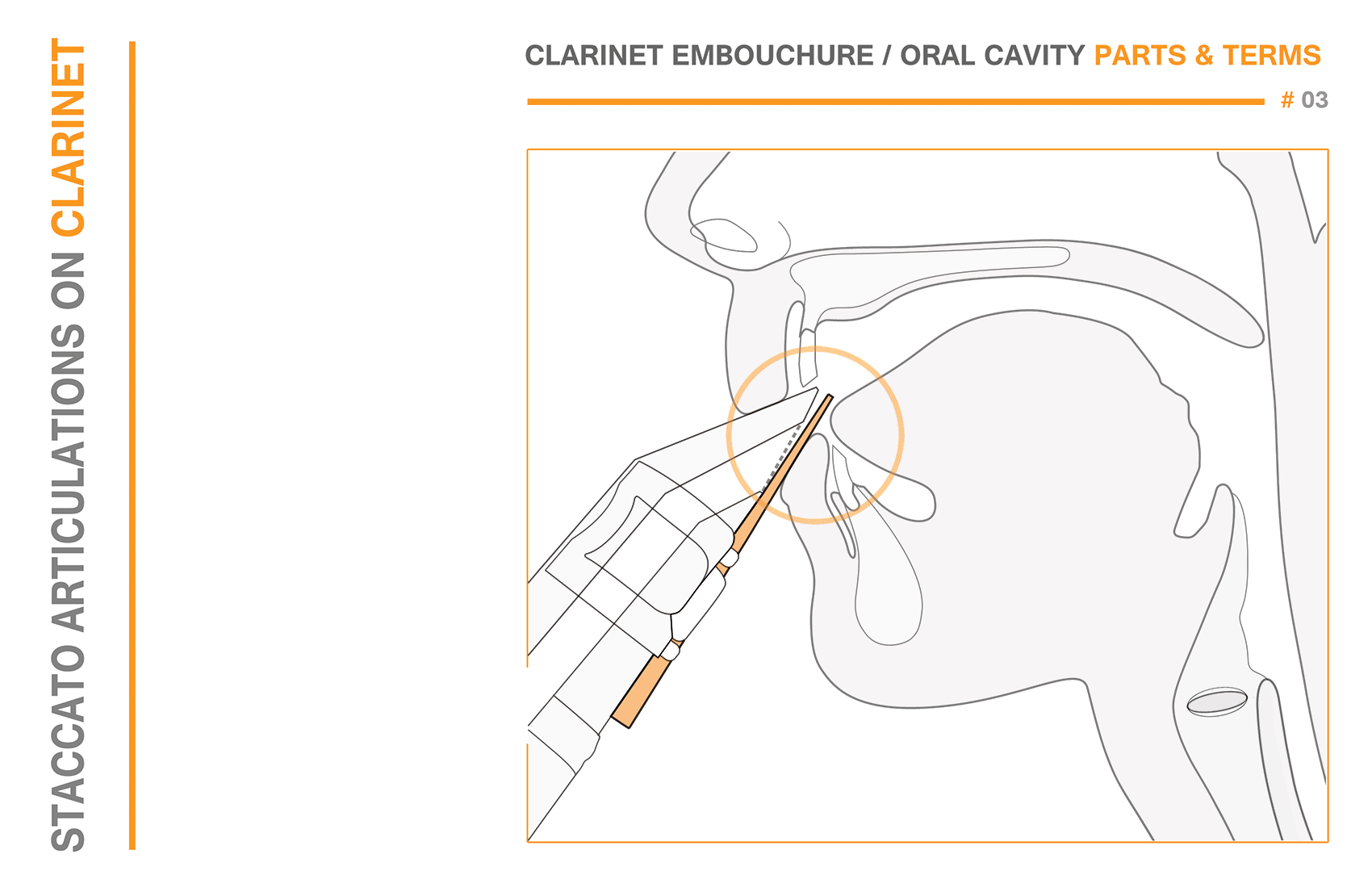
HISTORICAL BACKGROUND / DOUBLE-LIP EMBOUCHURE
In the eighteenth century, there was no standard approach to how players would have placed the mouthpiece in their mouth. It was partly due to the fact that at the very early stages when the clarinet was introduced into the orchestra it was played by oboists, who in principle use a double-lip embouchure. Using a double-lip embouchure allows placing the reed successfully against both: upper or lower lip.
UNTERSICHBLASEN & UBERSICHBLASEN TECHNIQUES
This led to the development of two simultaneously existing ways of playing the clarinet: using the untersichblasen technique [reed down; reed being dampened by vibrating against the lower lip] and the ubersichblasen technique [reed up; reed being dampened by vibrating against the upper lip]. Before the untersichblasen became the predominant way of playing the clarinet, Baroque and Classical clarinetists were known to use the ubersichblasen technique!
We know this because the XVIII and XIX century makers’ stamps engraved on the joints of early clarinets. Some of the instruments after being assembled and after having makers’ stamps aligned on all of the joints in a manner that they are visible from the front of the instrument, end up with the mouthpiece window facing up. These two ways of placing the reed have an effect upon the embouchure, which has an impact upon the position of the tongue. Consequently, the tongue position will determine the type and quality of articulation available to a player. This is why it is safe to say that both of these techniques call for different staccato articulation approach.
UBERSICHBLASEN / DIAPHRAGM PUFFS & GLOTTAL STOPS
By making the reed more difficult to access by the tongue, the ubersichblasen supports stopping the air column by the means of using glottal stops, known as the throat articulation [produced by imitating a coughing-like reflex or continuous pronunciation of syllable “GA” with simultaneous support of the diaphragm] or by creating single, repeated puffs of air [supplied by diaphragm pulsations] known as the chest articulation.

As mentioned before, both of these techniques existed side-by-side and as a consequence of that, early clarinetists could enjoy different ways of producing staccato articulation, which surely must have had a profound impact upon their concept of the clarinet sound. For instance, J. Frölich described the chest articulation [that is completely neglected in contemporary clarinet playing] in detail pointing out that it is the most ideal way to articulate on the clarinet because it is the closest to articulating notes while singing.
Another account of effectiveness of the chest articulation comes from a German composer and clarinetist of the time, F.J. Roeser, who in 1764 wrote that separating passages of running sixteenths is not practiced on the clarinet because of the use of the chest articulation [instead of the tongue] due to the placement of the reed deep in the mouth and right under the soft palate. He was referring to the ubersichblasen technique that appeared to be too slow for clear articulation of sixteenth notes in fast tempi.
What caries a great deal of importance and gives some food-for-thought about staccato articulation on the clarinet in general is that one of the brightest “founding fathers” of the great French School of clarinet playing, J-X. Lefevre , whose famous Methode de Clarinette of 1801 has served as the top example of clarinet pedagogy, he himself was a brilliant ubersichblasen technique user and promoter.
UNTERSICHBLASEN / DIAPHRAGM PUFFS & GLOTTAL STOPS
Despite the fact that the untersichblasen technique allows glottal stops and diaphragm puffs, it predominantly supports tongue-to-reed contact, which was instrumental in the development of the articulation that we call single-tonguing. One can make a practical guess that these features of the untersichblasen technique have won it’s popularity among clarinetists leading it to be the single, most commonly used articulation type to date.
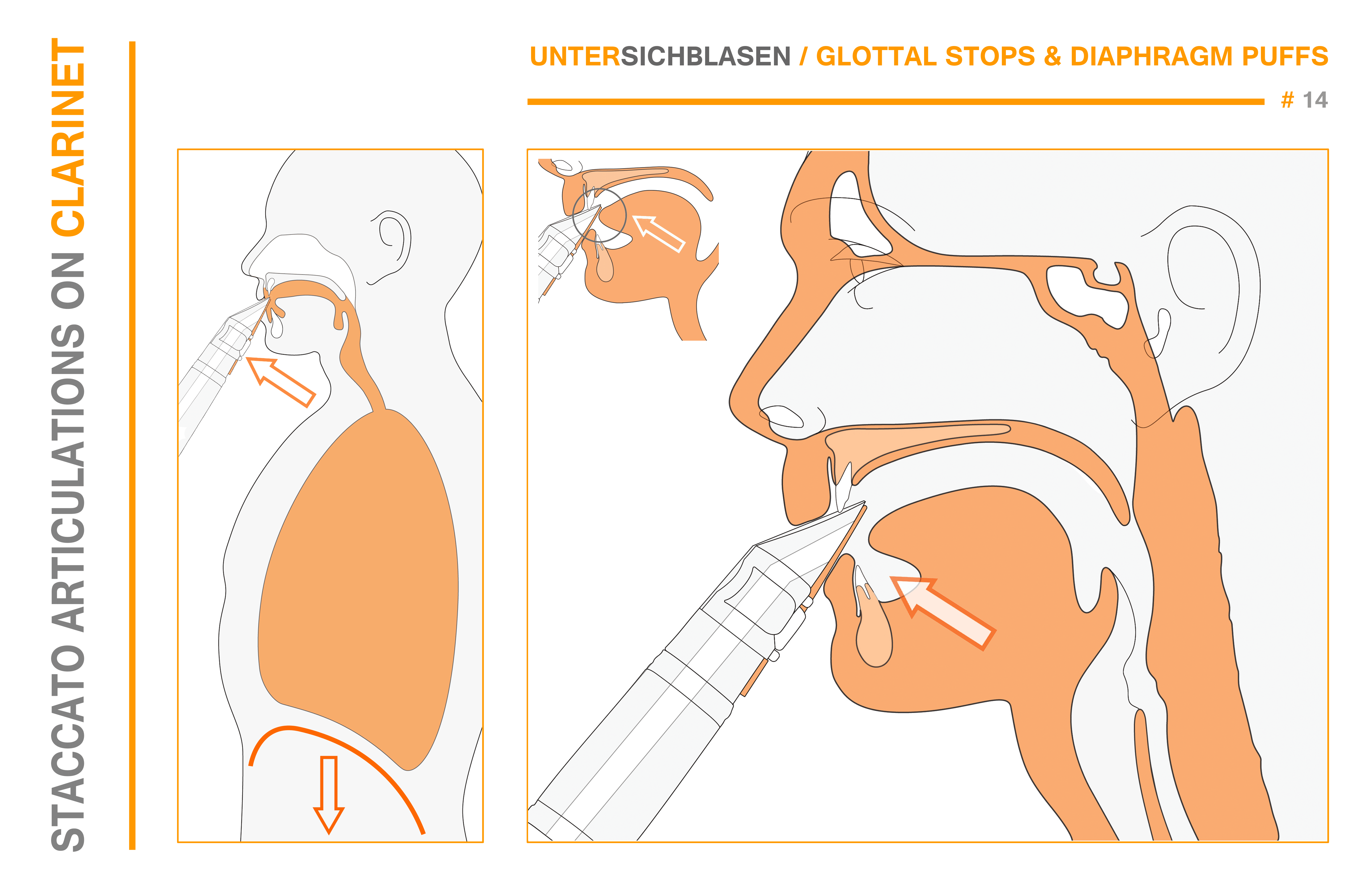
COMMON ARTICULATION TYPES
SINGLE TONGUING
- It is the most commonly used staccato articulation type on the clarinet.
- It allows a high quality staccato across the entire range of the instrument.
- It allows simultaneous changes of positioning of the TB & TD for uninterrupted voicing across all registers.
- Constant Tongue Tip motion to close and to open the reed creates the air pressure build-up behind the reed, which makes it subject to losing speed.
- It requires almost no embouchure adjustments.
- Depending of the proficiency of the player, it can be 100% effective at any – – speed and in any register.
CAUTION!
- The only problem with single tonguing effectiveness may appear at fast tempi in the upper registers.
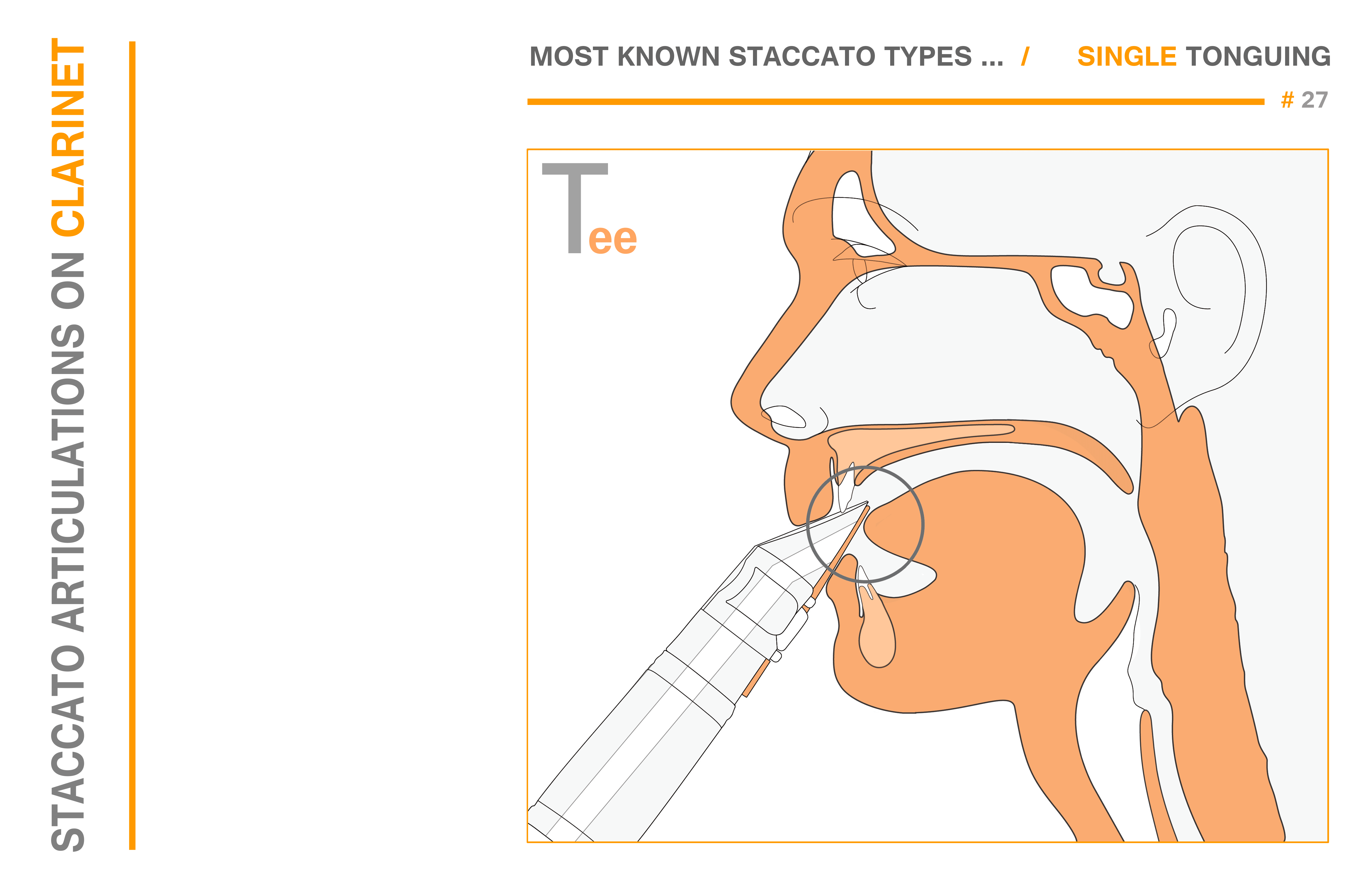
DOUBLE TONGUING
Double tonguing supports tongue-to-reed and tongue-to-palate contact. It is produced by employing a pendulum-like motion between the Tongue Tip touching the tip of the reed and the Tongue Dorsum touching the upper palate in the manner of pronouncing silent “TEE-KEE / TEE-KEE” syllabi.
- Facilitates execution of rapid staccato passages. [Usually, it doubles the speed of the single tonguing].
- Gets progressively more difficult in high registers.
- Tongue Dorsum continuously returns to the soft palate to articulate the KEE syllable limit the freedom of using it for uninterrupted voicing.
- Tongue Tip motion to close & to open the reed on the silent TEE syllable creates air pressure build-up behind the reed, which makes it a subject to loosing speed.
- It requires a continuous embouchure adjustments as well.
- Calls for a well established embouchure and high proficiency of playing.
CAUTION!
- Due to a continuous, swinging movement between TT and TB, it limits the freedom of positioning of the TD with accordance to register changes requirements resulting in poorer quality of execution in higher registers.

ALTERNATIVE ARTICULATIONS
LATERAL TONGUING
Lateral Tonguing – as its name implies – utilizes horizontal tongue motion in order to allow tongue tip to gently “brush” over the lower part of the tip of the reed to create the impression of separation of the sounds. This method was first introduced and described by K. Stein, who argued that it allows rapid staccato across all clarinet registers without constraining tongue functions responsible for register changes.
- Facilitates execution of rapid staccato passages.
- Horizontal motion of the Tongue Tip is responsible for producing it.
- As a result, it does not involve the Tongue Body/Dorsum movement in order to perform the KEE action.
- Once learned, this type does not get more difficult in high registers.
- Voicing remains uninterrupted.
- High proficiency of playing single tonguing is not a prerequisite.
CAUTION!
- Tongue Tip must brush horizontally over the area that is under the tip of the reed NOT directly against the very tip of the reed. If not done properly, it may result in minor tongue cuts and discomfort.
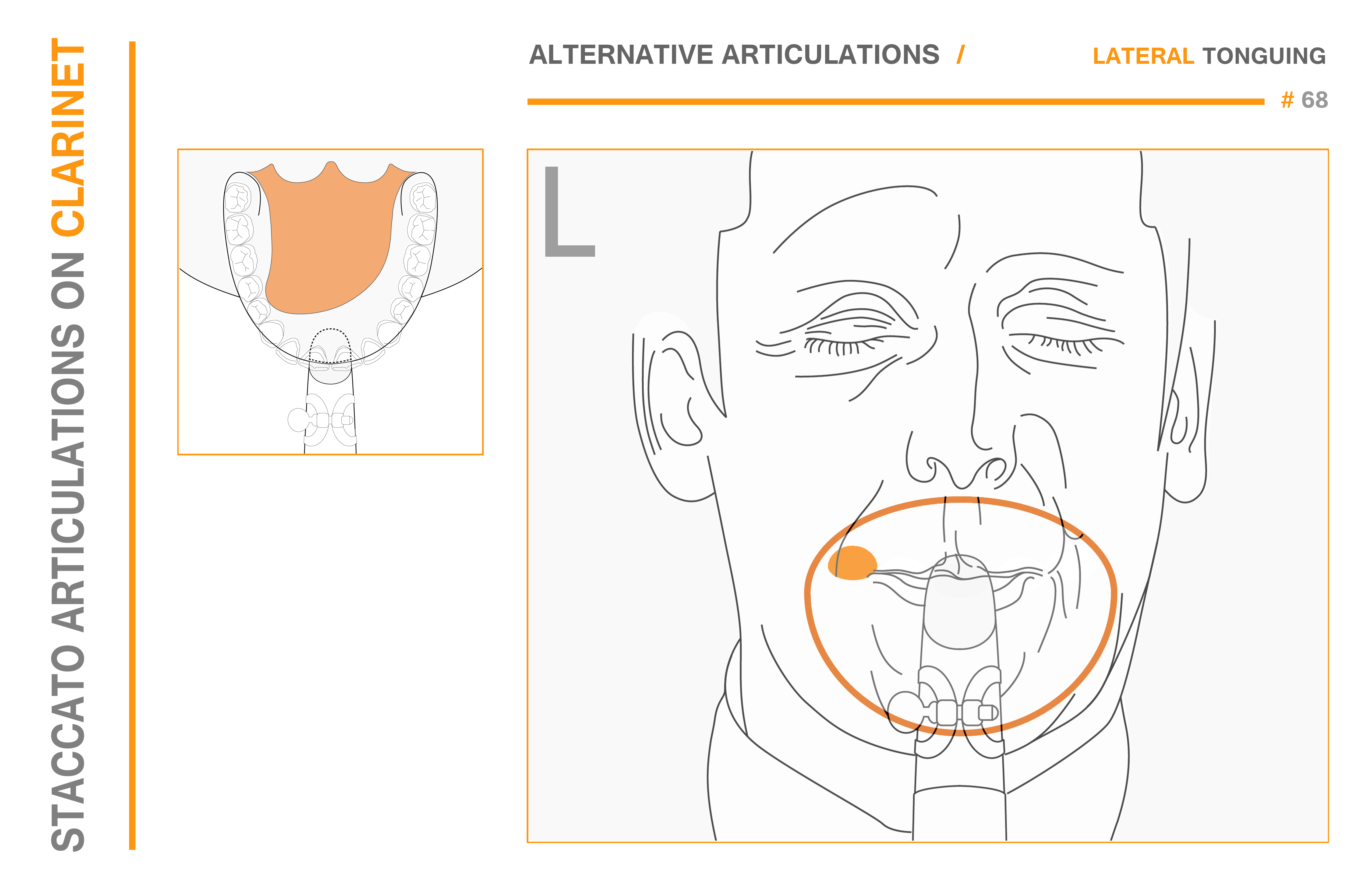
For more information on Dr. Kornel Wolak’s research or to purchase Articulation Types for Clarinet, please visit his website, kornelwolak.com.
A presentation of the research will also be given at the 7th European Clarinet Festival / ClarMeet Porto in December 2017.

Comments are closed.